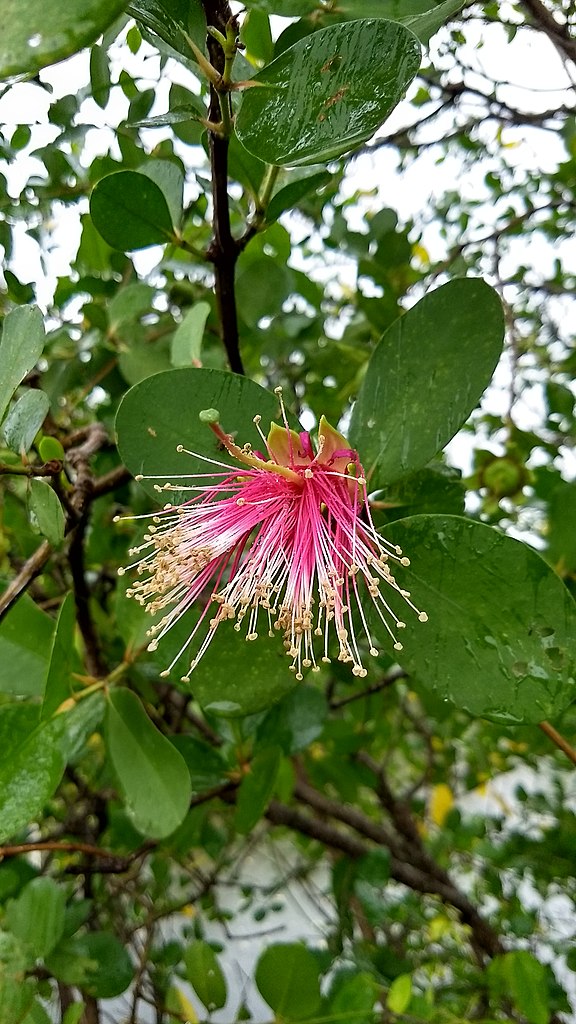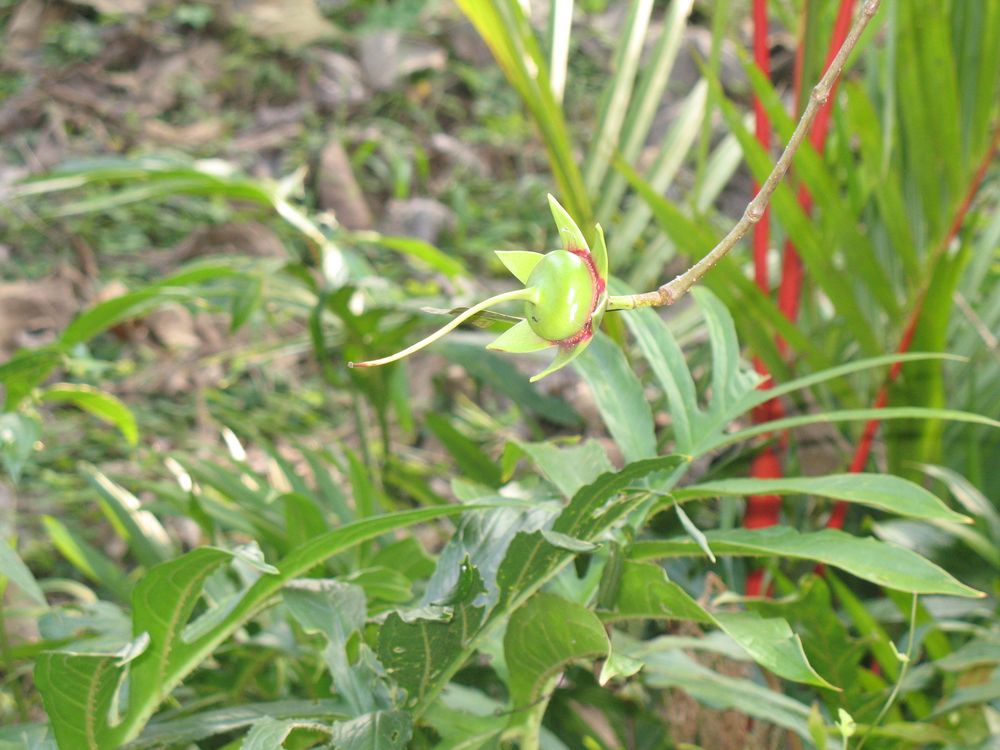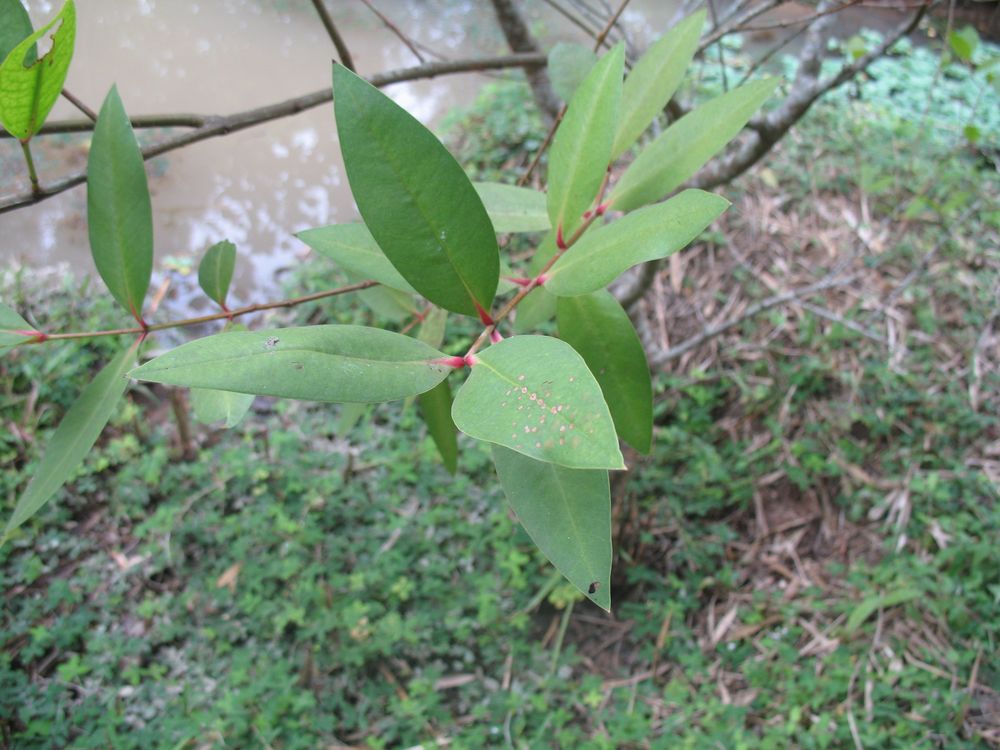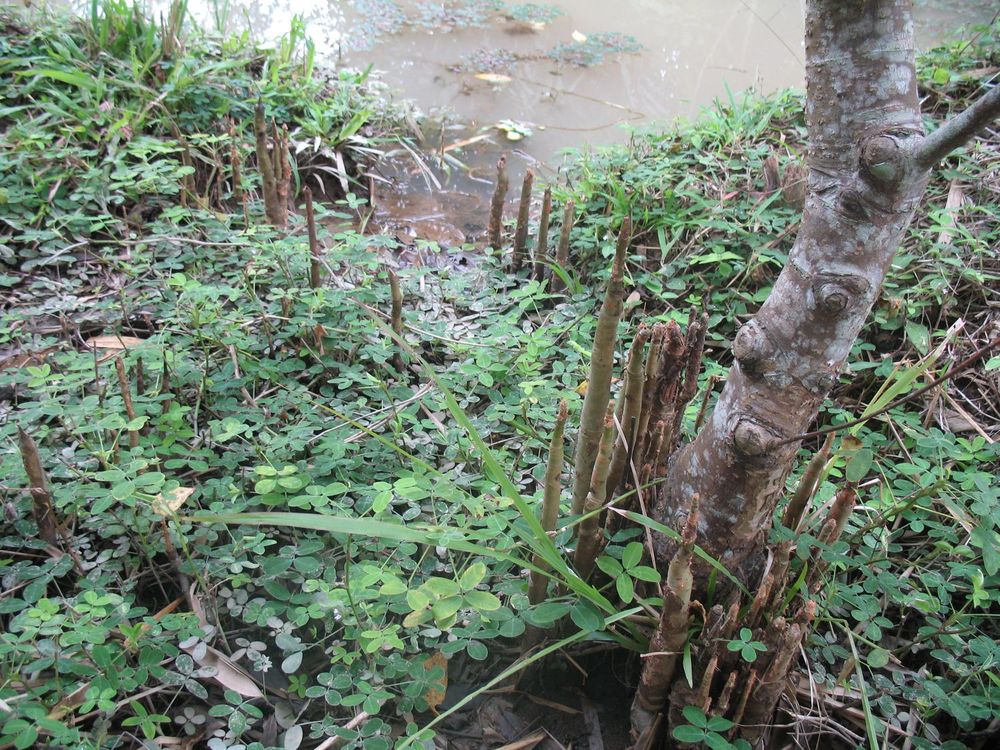Laos does not have a maritime shoreline, yet mangrove plants, probably imported, are sometimes found on the banks of rivers or ponds. Mangroves are known to be seashore ecosystems in tropical regions and include several species adapted to saline waters, including the Sonneratia; before botanists modified their taxonomy these plants belonged to the same group as the famous kok ten, Duabanga sonneratioides, whose family resemblance is obvious. Their name is dedicated to the French traveller botanist Pierre Sonnerat (1748-1814) who explored New Guinea, the Moluccas and South China.
Sonneratia caseolaris is a small evergreen tree with a slender trunk and numerous branches. The parchment-like leaves are opposite, oval and pointed at the top. The flowers have 6 narrow, dark red petals from which a large number of white stamens with a pink base form a tassel. They open in the evening and last only one night, producing abundant nectar that attracts pollinators (bats and insects). The fruit, surrounded by 6 horizontal triangular sepals, is a flattened berry. The aerial roots or pneumatophores, which allow the plant to breathe in the asphyxiating soil, grow from the mud around the tree; they are green at the beginning and can reach 2 metres in height at maturity.
Sonneratia is characteristic of the mangroves that extend along the maritime coasts from Africa to Indonesia and Australia; in Indochina, they are found at the mouth of the muddy estuaries of the large rivers (Chao Phraya, Mekong) and the along certain coasts (Gulf of Siam, China Sea, Gulf of Tonkin). It is easy to understand why, although they have a name in Thai, Cambodian and Vietnamese, they do not have one in Lao, at least not yet, as we were able to photograph this Sonneratia caseolaris on the edge of a pond near Luang Prabang. One can assume that the Lao, once they have tasted the fruit of this tree, will adopt it as do the Thais and Indonesians who eat it raw, when ripe, or cooked; according to some it has a guava flavour (it is sometimes called mangrove guava), according to others it is bitter and acidic at the same time; in Sri Lanka, it is used to make juice and jam. Fishermen can use pneumatophores to make floats for their nets. Soft wood is used to make matches or shoe soles. Finally, it is known to have medicinal properties: the very ripe fruits are used as a vermifuge, while when they are still green they are made into juice to treat coughs; the juice of the flowers is recommended in the case of blood in the urine.
Le Laos n’a pas de rivage maritime et pourtant on rencontre parfois au bord des cours d’eau ou des étangs des plantes de mangrove, sans doute importées. On sait que les mangroves sont des écosystèmes de bord de mer des régions tropicales comprenant un certain nombre d’espèces adaptées aux eaux salines, dont les Sonneratia; avant que les botanistes ne modifient leur taxinomie ces plantes appartenaient au même groupe que le fameux kok ten, Duabanga sonneratioides, dont l’air de famille est évident. Leur nom est dédié au botaniste voyageur français Pierre Sonnerat (1748-1814) qui explora la Nouvelle-Guinée, Les Moluques et le Sud de la Chine.
Sonneratia caseolaris est un petit arbre toujours vert au tronc mince et aux branches nombreuses. Les feuilles parcheminées sont opposées, ovales et pointues au sommet. Les fleurs ont 6 pétales étroits et rouge foncé d’où s’échappe une grande quantité d’étamines blanches à base rose formant houppe elles s’ouvrent le soir et ne durent qu’une nuit produisant un abondant nectar qui attire les pollinisateurs (chauve-souris et insectes). Le fruit entouré des 6 sépales triangulaire à l’horizontal est une baie aplatie. Autour de l’arbre surgissent de la boue les racines aériennes ou pneumatophores qui permettent à la plante de respirer dans un sol asphyxiant; de forme conique ils sont verts au début et peuvent atteindre 2 mètres à maturité.
Les Sonneratia sont caractéristiques des mangroves qui s’étendent le long des côtes maritimes depuis l’Afrique jusqu’à l’Indonésie et l’Australie; en Indochine on les rencontre à l’embouchure des estuaires vaseux des grands fleuves (Chao Phraya, Mékong) et le long de certaines côtes (Golfe du Siam, Mer de Chine, Golfe du Tonkin). On comprend bien pourquoi, alors qu’ils ont un nom en thaï, cambodgien et vietnamien, ils n’en n’ont pas en lao, du moins pas encore puisque nous avons pu photographier ce Sonneratia caseolaris au bord d’un étang proche de Louang Prabang. On peut supposer que les Lao, quand ils auront goûté au fruit de cet arbre l’adopteront comme le font les Thaï et les Indonésien qui le consomment cru, à maturité, ou cuit; selon les uns, il a une saveur de goyave (on le nomme parfois mangrove guava), selon les autres, il est amer et acide à la fois; au Sri Lanka on en fait des jus et des confitures. Les pêcheurs peuvent utiliser les pneumatophores pour faire des flotteurs pour leur filet. Le bois tendre permet de fabriquer des allumettes ou des semelles de chaussures. Enfin, des propriétés médicinales lui sont reconnues ici et là: les fruits très mûrs sont employés comme vermifuge, alors que lorsqu’ils sont encore verts on en fait du jus pour soigner la toux; le jus des fleurs est recommandé en cas de sang dans les urines.




Laos does not have a maritime shoreline, yet mangrove plants, probably imported, are sometimes found on the banks of rivers or ponds. Mangroves are known to be seashore ecosystems in tropical regions and include several species adapted to saline waters, including the Sonneratia; before botanists modified their taxonomy these plants belonged to the same group as the famous kok ten, Duabanga sonneratioides, whose family resemblance is obvious. Their name is dedicated to the French traveller botanist Pierre Sonnerat (1748-1814) who explored New Guinea, the Moluccas and South China.
Sonneratia caseolaris is a small evergreen tree with a slender trunk and numerous branches. The parchment-like leaves are opposite, oval and pointed at the top. The flowers have 6 narrow, dark red petals from which a large number of white stamens with a pink base form a tassel. They open in the evening and last only one night, producing abundant nectar that attracts pollinators (bats and insects). The fruit, surrounded by 6 horizontal triangular sepals, is a flattened berry. The aerial roots or pneumatophores, which allow the plant to breathe in the asphyxiating soil, grow from the mud around the tree; they are green at the beginning and can reach 2 metres in height at maturity.
Sonneratia is characteristic of the mangroves that extend along the maritime coasts from Africa to Indonesia and Australia; in Indochina, they are found at the mouth of the muddy estuaries of the large rivers (Chao Phraya, Mekong) and the along certain coasts (Gulf of Siam, China Sea, Gulf of Tonkin). It is easy to understand why, although they have a name in Thai, Cambodian and Vietnamese, they do not have one in Lao, at least not yet, as we were able to photograph this Sonneratia caseolaris on the edge of a pond near Luang Prabang. One can assume that the Lao, once they have tasted the fruit of this tree, will adopt it as do the Thais and Indonesians who eat it raw, when ripe, or cooked; according to some it has a guava flavour (it is sometimes called mangrove guava), according to others it is bitter and acidic at the same time; in Sri Lanka, it is used to make juice and jam. Fishermen can use pneumatophores to make floats for their nets. Soft wood is used to make matches or shoe soles. Finally, it is known to have medicinal properties: the very ripe fruits are used as a vermifuge, while when they are still green they are made into juice to treat coughs; the juice of the flowers is recommended in the case of blood in the urine.
Le Laos n’a pas de rivage maritime et pourtant on rencontre parfois au bord des cours d’eau ou des étangs des plantes de mangrove, sans doute importées. On sait que les mangroves sont des écosystèmes de bord de mer des régions tropicales comprenant un certain nombre d’espèces adaptées aux eaux salines, dont les Sonneratia; avant que les botanistes ne modifient leur taxinomie ces plantes appartenaient au même groupe que le fameux kok ten, Duabanga sonneratioides, dont l’air de famille est évident. Leur nom est dédié au botaniste voyageur français Pierre Sonnerat (1748-1814) qui explora la Nouvelle-Guinée, Les Moluques et le Sud de la Chine.
Sonneratia caseolaris est un petit arbre toujours vert au tronc mince et aux branches nombreuses. Les feuilles parcheminées sont opposées, ovales et pointues au sommet. Les fleurs ont 6 pétales étroits et rouge foncé d’où s’échappe une grande quantité d’étamines blanches à base rose formant houppe elles s’ouvrent le soir et ne durent qu’une nuit produisant un abondant nectar qui attire les pollinisateurs (chauve-souris et insectes). Le fruit entouré des 6 sépales triangulaire à l’horizontal est une baie aplatie. Autour de l’arbre surgissent de la boue les racines aériennes ou pneumatophores qui permettent à la plante de respirer dans un sol asphyxiant; de forme conique ils sont verts au début et peuvent atteindre 2 mètres à maturité.
Les Sonneratia sont caractéristiques des mangroves qui s’étendent le long des côtes maritimes depuis l’Afrique jusqu’à l’Indonésie et l’Australie; en Indochine on les rencontre à l’embouchure des estuaires vaseux des grands fleuves (Chao Phraya, Mékong) et le long de certaines côtes (Golfe du Siam, Mer de Chine, Golfe du Tonkin). On comprend bien pourquoi, alors qu’ils ont un nom en thaï, cambodgien et vietnamien, ils n’en n’ont pas en lao, du moins pas encore puisque nous avons pu photographier ce Sonneratia caseolaris au bord d’un étang proche de Louang Prabang. On peut supposer que les Lao, quand ils auront goûté au fruit de cet arbre l’adopteront comme le font les Thaï et les Indonésien qui le consomment cru, à maturité, ou cuit; selon les uns, il a une saveur de goyave (on le nomme parfois mangrove guava), selon les autres, il est amer et acide à la fois; au Sri Lanka on en fait des jus et des confitures. Les pêcheurs peuvent utiliser les pneumatophores pour faire des flotteurs pour leur filet. Le bois tendre permet de fabriquer des allumettes ou des semelles de chaussures. Enfin, des propriétés médicinales lui sont reconnues ici et là: les fruits très mûrs sont employés comme vermifuge, alors que lorsqu’ils sont encore verts on en fait du jus pour soigner la toux; le jus des fleurs est recommandé en cas de sang dans les urines.








Laos does not have a maritime shoreline, yet mangrove plants, probably imported, are sometimes found on the banks of rivers or ponds. Mangroves are known to be seashore ecosystems in tropical regions and include several species adapted to saline waters, including the Sonneratia; before botanists modified their taxonomy these plants belonged to the same group as the famous kok ten, Duabanga sonneratioides, whose family resemblance is obvious. Their name is dedicated to the French traveller botanist Pierre Sonnerat (1748-1814) who explored New Guinea, the Moluccas and South China.
Sonneratia caseolaris is a small evergreen tree with a slender trunk and numerous branches. The parchment-like leaves are opposite, oval and pointed at the top. The flowers have 6 narrow, dark red petals from which a large number of white stamens with a pink base form a tassel. They open in the evening and last only one night, producing abundant nectar that attracts pollinators (bats and insects). The fruit, surrounded by 6 horizontal triangular sepals, is a flattened berry. The aerial roots or pneumatophores, which allow the plant to breathe in the asphyxiating soil, grow from the mud around the tree; they are green at the beginning and can reach 2 metres in height at maturity.
Sonneratia is characteristic of the mangroves that extend along the maritime coasts from Africa to Indonesia and Australia; in Indochina, they are found at the mouth of the muddy estuaries of the large rivers (Chao Phraya, Mekong) and the along certain coasts (Gulf of Siam, China Sea, Gulf of Tonkin). It is easy to understand why, although they have a name in Thai, Cambodian and Vietnamese, they do not have one in Lao, at least not yet, as we were able to photograph this Sonneratia caseolaris on the edge of a pond near Luang Prabang. One can assume that the Lao, once they have tasted the fruit of this tree, will adopt it as do the Thais and Indonesians who eat it raw, when ripe, or cooked; according to some it has a guava flavour (it is sometimes called mangrove guava), according to others it is bitter and acidic at the same time; in Sri Lanka, it is used to make juice and jam. Fishermen can use pneumatophores to make floats for their nets. Soft wood is used to make matches or shoe soles. Finally, it is known to have medicinal properties: the very ripe fruits are used as a vermifuge, while when they are still green they are made into juice to treat coughs; the juice of the flowers is recommended in the case of blood in the urine.
Le Laos n’a pas de rivage maritime et pourtant on rencontre parfois au bord des cours d’eau ou des étangs des plantes de mangrove, sans doute importées. On sait que les mangroves sont des écosystèmes de bord de mer des régions tropicales comprenant un certain nombre d’espèces adaptées aux eaux salines, dont les Sonneratia; avant que les botanistes ne modifient leur taxinomie ces plantes appartenaient au même groupe que le fameux kok ten, Duabanga sonneratioides, dont l’air de famille est évident. Leur nom est dédié au botaniste voyageur français Pierre Sonnerat (1748-1814) qui explora la Nouvelle-Guinée, Les Moluques et le Sud de la Chine.
Sonneratia caseolaris est un petit arbre toujours vert au tronc mince et aux branches nombreuses. Les feuilles parcheminées sont opposées, ovales et pointues au sommet. Les fleurs ont 6 pétales étroits et rouge foncé d’où s’échappe une grande quantité d’étamines blanches à base rose formant houppe elles s’ouvrent le soir et ne durent qu’une nuit produisant un abondant nectar qui attire les pollinisateurs (chauve-souris et insectes). Le fruit entouré des 6 sépales triangulaire à l’horizontal est une baie aplatie. Autour de l’arbre surgissent de la boue les racines aériennes ou pneumatophores qui permettent à la plante de respirer dans un sol asphyxiant; de forme conique ils sont verts au début et peuvent atteindre 2 mètres à maturité.
Les Sonneratia sont caractéristiques des mangroves qui s’étendent le long des côtes maritimes depuis l’Afrique jusqu’à l’Indonésie et l’Australie; en Indochine on les rencontre à l’embouchure des estuaires vaseux des grands fleuves (Chao Phraya, Mékong) et le long de certaines côtes (Golfe du Siam, Mer de Chine, Golfe du Tonkin). On comprend bien pourquoi, alors qu’ils ont un nom en thaï, cambodgien et vietnamien, ils n’en n’ont pas en lao, du moins pas encore puisque nous avons pu photographier ce Sonneratia caseolaris au bord d’un étang proche de Louang Prabang. On peut supposer que les Lao, quand ils auront goûté au fruit de cet arbre l’adopteront comme le font les Thaï et les Indonésien qui le consomment cru, à maturité, ou cuit; selon les uns, il a une saveur de goyave (on le nomme parfois mangrove guava), selon les autres, il est amer et acide à la fois; au Sri Lanka on en fait des jus et des confitures. Les pêcheurs peuvent utiliser les pneumatophores pour faire des flotteurs pour leur filet. Le bois tendre permet de fabriquer des allumettes ou des semelles de chaussures. Enfin, des propriétés médicinales lui sont reconnues ici et là: les fruits très mûrs sont employés comme vermifuge, alors que lorsqu’ils sont encore verts on en fait du jus pour soigner la toux; le jus des fleurs est recommandé en cas de sang dans les urines.


